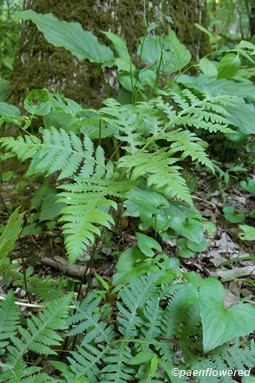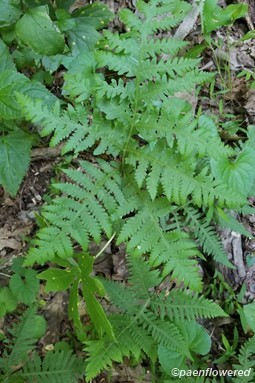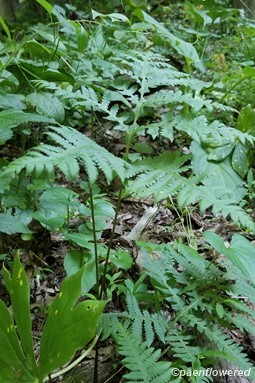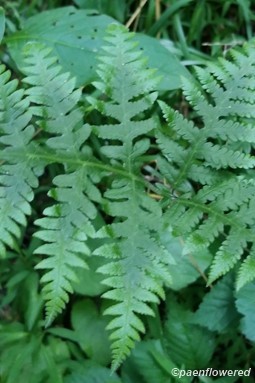Phegopteris hexagonoptera
Crushed leaves of this fern produce a fragrant smell
Phegopteris hexagonoptera broad beech fern
Add to MyPlants View Locations
This fern is easily identified by the lowest pair of pinnae that are significantly larger and broader than the pair above. This fern grows further south than its sibling Phegopteris connectilis and is not very tolerant of high summer temperatures, and so is usually found in the shade.
Habitat & Range
Moist, rich woods. Humus-rich, sightly acidic soil.
Range is from Quebec to the Gulf States, rare in colder states and Canada.
Wetland code: FAC
Characteristics
Fronds 7 to 17 in. long. Sterile and fertile fronds are the same shape and size.
Blade 6 to 13 in. Usually as broad or broader than long, distinctly triangular with the longest pinnae near the base. Tilts backward; slightly hairy, and dull green. Cut into 12 or so almost opposite pairs of pinnae.
Pinnae double-tapered, widest at about middle. Deeply cut almost to the rachis, but pinnae are connected along the rachis by winged tissue. Two lowest pairs are largest, broadest-spreading, and usually more distantly spaced from the next set of pinnae, with the rachis between broadly winged.
Rachis green, winged throughout, with whitish scales.
Stipe 6 to 16 in. long. Slightly longer than blade; slender, straw-colored, smooth above, darker and slightly scaly and hairy at base.
Rhizome slender, very scaly, black, widely creeping, and branching.
Sori small, round, scattered in a single row near margins just before the end of the vein. No indusium.
Identification Tips
Winged rachis throughout including between the two lowest pairs of pinnae
Phegopteris hexagonoptera broad beech fern
Synonyms: Thelypteris hexagonopteraAdd to MyPlants View Locations









Comments
Have you spotted this plant in your area? We'd love to hear about your experience! Share your comments or questions about the plant below. Comments are moderated before posting.